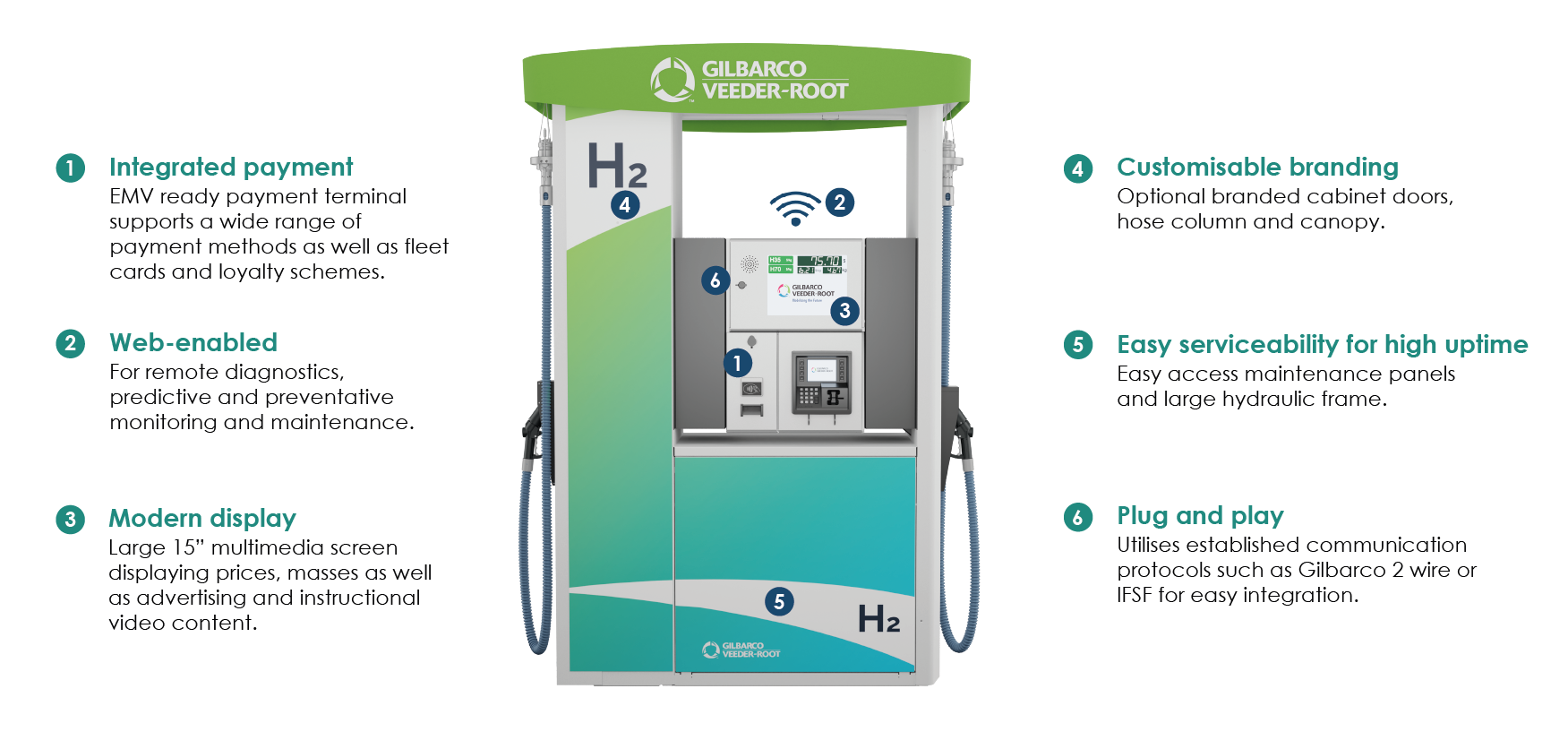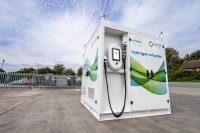- What does a hydrogen refueling station (HRS) comprise?
- What role do hydrogen dispensers play in hydrogen refueling solutions, and how do they operate?
- What types of vehicles would refuel at a hydrogen refueling station?
- How does hydrogen arrive at a site and how is it stored?
- How do hydrogen compressors contribute to the efficiency of hydrogen refueling systems, and what are their key characteristics?
- State and explain the primary challenges in developing a hydrogen refueling infrastructure, and how are they being addressed?
- Where are hydrogen refueling stations located and how many hydrogen stations are needed to serve the needs of drivers?
- How do hydrogen refueling solutions compare to traditional internal combustion engine (ICE) and electric vehicle fueling/charging in terms of efficiency and environmental impact?
- What role do automation and remote monitoring play in ensuring the reliability and availability of hydrogen refueling stations?
- Describe the regulatory and standardization aspects related to hydrogen refueling solutions and how they impact the industry.
Browse all hydrogen refueling solutions from leading suppliers on our marketplace!
What does a hydrogen refueling station (HRS) comprise?
A hydrogen refueling station typically comprises the following:
- Storage: Above-ground high-pressure storage cylinders. Available in 500 bar or 1000 bar, and in multiples depending on site throughput.
- Compression: It is used for taking low-pressure hydrogen gas, compressing it to high pressures, and dispensing it into hydrogen-powered vehicles.
- Gas Management Panel: The gas management panel controls the interface between system components and controls the flow of gas through the station.
- Chiller: The chiller cools gas directly or indirectly via a heat exchanger to prepare it for safe dispensing into vehicles.
- Dispenser: Dispensers deliver hydrogen fuel to vehicles at either 350 bar or 700 bar and include a user-friendly interface for a familiar refueling experience.
What role do hydrogen dispensers play in hydrogen refueling solutions, and how do they operate?
- Hydrogen dispensers are a crucial component in hydrogen refueling solutions, serving as the direct user interface between the hydrogen source and a hydrogen-powered vehicle.
- H2 dispensers are designed to safely and efficiently deliver hydrogen gas into the vehicle’s storage tanks. The process is a familiar experience and not much different than filling up a car with petrol or diesel.
What types of vehicles would refuel at a hydrogen refueling station?
In principle, any hydrogen-powered vehicle could refuel at a hydrogen station. The most common type of hydrogen-powered vehicles are fuel cell electric vehicles or ‘FCEVs’, however, we are also seeing hydrogen combustion technology entering the market.
Hydrogen is particularly well-suited for heavy-duty applications such as trucks, buses, trains, and ships due to its impressive energy-to-weight ratio. Its high energy density enables efficient energy storage, allowing these vehicles to cover long distances without a substantial increase in weight.

Example: Hydrogen refueling solution
How does hydrogen arrive at a site and how is it stored?
- Gaseous Hydrogen can be produced on-site through electrolysis or steam methane reformation (SMR). It can also be delivered to a site and can arrive in a liquid or gaseous state.
- Hydrogen turns into a liquid at very low temperatures (-253°C/-423°F) and is stored in cryogenic tanks to maintain the cold temperatures required for its liquid state. Liquid hydrogen takes up less space than gaseous hydrogen, making it suitable for transporting and storing large quantities, especially in limited-space applications and long-distance transportation. Liquid hydrogen is delivered to sites via cryogenic tanker trucks and is vaporized on-site to provide gaseous hydrogen for fueling.
- Gaseous Hydrogen is transported to stations via tube trailers. The tubes of hydrogen are large, high-pressure cylinders that hold hydrogen at a very high pressure (200-550Bar) to maximize the amount of hydrogen stored in them. The tubes are designed to withstand high pressures and are often equipped with safety features like pressure relief devices and burst discs to ensure safe operation.
How do hydrogen compressors contribute to the efficiency of hydrogen refueling systems, and what are their key characteristics?
Hydrogen compressors play a vital role in enhancing the efficiency of hydrogen refueling systems. They achieve this by compressing hydrogen gas to high pressures, a crucial step for efficient storage and transportation. The compression process reduces the volume occupied by hydrogen, enabling the storage of larger quantities within a limited space. Additionally, the increased pressure facilitated by these compressors ensures rapid and efficient refueling, enhancing the overall user experience. To guarantee safe operation, compressors are equipped with safety features such as pressure relief valves and leak detection systems.
The compressors should be equipped with advanced control systems that monitor and regulate pressure and temperature, ensuring both safety and efficiency in their operation. The compressors must feature an oil-free, abrasion-resistant, and leak-free design. The hydraulic system is expertly crafted for efficiency, extending the service life. These features must also be accessible in real-time through remote monitoring, leading to maximum uptime and optimal performance.
State and explain the primary challenges in developing a hydrogen refueling infrastructure, and how are they being addressed?
Of course a filling station accommodating dual pressure dispensing will initially incur higher capital expenditure. However, due to the overall reduction of total cost of ownership by way of integrating multiple pressure levels into one station, the initial investment is subject to a higher rate of amortization.
a.) There are some primary challenges in developing the hydrogen refueling infrastructure, most attributed to the cost of developing stations and the availability of fuel and vehicles.
- High investment: Hydrogen refueling stations require a large upfront investment for equipment, land, and infrastructure. To overcome this challenge, government incentives, subsidies, and public-private partnerships are being used to provide financial support to station developers. HRS Solutions must be engineered with the intent to achieve a low total cost of ownership, offering maximum uptime, durability, modularity, and scalability to optimize investment.
- Building the infrastructure: The limited availability of hydrogen-powered vehicles can deter the development of public stations. Fortunately, we are seeing more and more vehicle manufacturers (OEMs) partnering with hydrogen suppliers to provide hydrogen stations. Fleet operators and transit companies are adopting hydrogen-powered buses and trucks to create a consistent demand for stations.
b.) Continued investment in research, development, and infrastructure, along with supportive policies and incentives, is essential to overcoming these challenges and establishing a robust and widespread hydrogen refueling infrastructure.
Where are hydrogen refueling stations located and how many hydrogen stations are needed to serve the needs of drivers?
- There are a variety of websites and databases that track existing and future hydrogen stations, for example, https://www.h2stations.org/.
- The exact number of stations needed depends on several factors, such as distance between stations, the driving range of hydrogen vehicles, and overall demand for hydrogen as a fuel. Hydrogen stations will need to be strategically placed along trucking routes throughout out-of-town areas. Heavy-duty hydrogen-powered vehicles can drive up to 500km on one tank, but stations need to be placed in the right locations.
How do hydrogen refueling solutions compare to traditional internal combustion engine (ICE) and electric vehicle fueling/charging in terms of efficiency and environmental impact?
- Hydrogen-powered vehicles boast the unique advantage of emitting only water vapor, resulting in zero tailpipe emissions. This eco-friendly benefit can make them a much greener solution, especially when the hydrogen used is produced from renewable energy sources. When hydrogen is produced from non-renewable energy sources, there are still varying amounts of greenhouse gas emissions involved in the hydrogen production process, depending on the energy source.
- ICE vehicles emit greenhouse gases and pollutants which contribute to air quality degradation and climate change.
- Electric vehicles (EVs) do not produce tailpipe emissions, but similarly to hydrogen, their environmental impact is influenced by the source of electricity. If the electricity is derived from fossil fuels, there are still greenhouse gas emissions involved. Additionally, there are environmental concerns related to the energy-intensive process of lithium-ion battery production and mining for rare metals associated with EVs.
What role do automation and remote monitoring play in ensuring the reliability and availability of hydrogen refueling stations?
Automation and remote monitoring enhance the reliability and availability of hydrogen refueling stations by enabling real-time monitoring, predictive maintenance, and remote diagnostics resulting in optimized operation, immediate response to issues, and enhanced security. This level of real-time data provides increased uptime and ensures a seamless user experience.
Describe the regulatory and standardization aspects related to hydrogen refueling solutions and how they impact the industry.
a.) Regulations and standardization play a crucial role in ensuring a safe and reliable hydrogen infrastructure. They promote safety and the sustainable growth of the hydrogen fueling industry, while promoting innovation and instilling confidence in consumers to drive the adoption of hydrogen as a clean and sustainable energy source.
b.) SAE J2601 and SAE J2601-2 are standards developed by the Society of Automotive Engineers (SAE) that define the procedures and guidelines for the safe fueling of hydrogen-powered vehicles. These standards promote consistency and reliability for hydrogen fueling:
- SAE J2601 – Standard protocols for fueling hydrogen-powered light-duty passenger cars and trucks.
- SAE J2601-2 – Standard protocols for fueling hydrogen-powered medium and heavy-duty vehicles such as buses and trucks. This was added as an extension of SAE J2601 to include higher flow rates and larger fueling capacities.
c.) National Fire Protection Association (NFPA) in the United States and the European Commission in Europe establish mandatory codes and standards to ensure the safe design, construction, and operation of hydrogen refueling stations.
Content contributed by Gilbarco Veeder Root
With 150 years’ experience and global reach, Gilbarco Veeder-Root are providers of innovative refueling solutions spanning a range of traditional and alternative fuels, for both public and private applications. Gilbarco Veeder-Root’s all-new suite of hydrogen station technologies is built on its legacy of expertly engineered dispensing technology, backed by more than 30 years’ experience in compressed gases at its Wisconsin-based unit, ANGI Energy Systems. Gilbarco Veeder-Root can cater for all your hydrogen station needs, from a single dispenser to a complete refuelling station – please get in touch for a no obligation discussion around your requirements today.
Last update: 06.12.2023








